Korg handled it very well. While all those rumours about the new ARP 2600 were circulating, the innovative Japanese company slipped the minilogue onto the market. And we’re all enamoured. Well, most of us are …
The word “minilogue” itself is simple, but nonetheless genious. MINImoog and anaLOGUE, voilà: MINILOGUE. That’s what we think that they were thinking. In any case, to tell the truth, the new Korg has not all that much in common with Moog. It is an exceptional and – new – analog(ue) synth in the mid/lower price category.
“New”, of course, is utterly impossible in the world of analog synths. Nothing is really new. The Moog System 55 at the end of the 60s / beginning of the 70s said all there was to say. Analog sound architecture had already reached its limits.
These days, in the digital world, analog synths are combined with MIDI and USB, motion sequencer and lots of memories … there you go: minilogue! New, small, an analog / digital miracle.
New analog sound design
“The synth circuits for minilogue are all new designs from the ground up, delivering a synthesizer experience like no other. Unprecedented in this class, it’s a four-voice polyphonic true-analog synth with an interface […] designed for accessibility.”
Korg praises its new analog baby and its newly designed analog circuit boards … ok, whatever, the user HEARS that this sound is definitely analog.
The 4-voice minilogue offers:
- 2 VCOs per voice, with sync and wave shape capability
- Cross-modulation, ring-modulation and noise
- A 12/24dB LowPass VCF per voice
- 2 ADSRs (VCA and VCF) per voice
- A global VC LFO (to PITCH, SHAPE and CUTOFF)
- Polyphonic step-sequencer (16 steps) with 4 motion-tracks, arpeggiator
- 8 voice modes, tape-style delay effect
- 100 factory-sounds plus 100 “INIT” memory locations (200 memories all in all)
- MIDI, USB, sync IN/OUT, audio IN/OUT, phones output
Most of this is stuff you already know. There are not gonna be too many BIG surprises here. The VCOs sound really good, the VCF is – as usual – powerful (although less colorful than the MS-20 filter), the envelopes are snappy … So, what’s so special about all this?
All these advantages …
You wanna hear the good side first? The sound is refreshing, individual and somehow inspiring. Whereby the sum of all the little parts plays a big role here: various playing modes (unison, chord, …), internal delay effect, the sequencer’s motion tracks and much more lets you submerge in a world of flexible musical performance and intuitive sounds.
A plattform for experimental sounds. There’s cross-modulation, ring-modulation, sync, noise, SHAPE modulation, the VC LFO, an internal delay-effekt, a flexible slider, etc. Heaps of features for the knob tweaker and sound designer …
“Tape-Style” delay effect with a feedback loop. The delay effect is combined with a High Pass filter – with various routing options. The delay’s feedback is a bit noisy, but very interesting! Fun to play with and a great source for exceptional sounds …
In the little display (about the size of a postage stamp), you can see the routings clearly … the display is small AND readable. Switching to oscilloscope mode, it provides visual feedback of parameter changes. Great fun!
A flexible slider. The Slider offers real-time control over a specific parameter of your choice. In addition, the slider can be used as a pitch bend controller.
Pitch bend range can be adjusted separately (1 ~ 12 notes) for UP and DOWN.
8 selectable voice modes let you freely configure the four voices for performance. The voices can be set to four note polyphony for chords or layered for thick basses and leads. There is:
- POLY – operates as a four-voice polyphonic synthesizer
- DUO – operates as a unison two-voice polyphonic synthesizer
- UNISON – operates as an all-unison mono synthesizer
- MONO – operates as a mono synth with sub-oscillator
- CHORD – produces chords
- DELAY – voices 2–4 sound consecutively at a delay following voice 1
- ARP – an arpeggiator operates with up to four voices
- SIDE CHAIN – when a note sounds, the volume of the preceding voice is lowered
From subtle mono-sounds to elephantine unison-sounds … the voice modes are a core feature of the minilogue. Useful – flexible – superb.
The step-sequencer is very simple to use. And that’s very nice! Just record the notes and that’s it. The additional motion sequencer can automate up to 4 synth parameters. And the result? Lively, sometimes unforseeable results.
[In-depth sequ programming might become complex, though. Gate time (programmable per step) … 0 – 100%, TIE; sequ lenght (16 notes maximum, sadly); global step resolution; etc. In studio, you might be quicker using a standard software-sequencer.]
Intuitive operation, clear menue structure. Tweaking the knobs is not a challenge at all. But what about all those hidden functions, the global parameters, the sub-menues?
As you see in the graphic, there are “quite a few” parameters the minilogue has to deal with. The instrument offers 3 EDIT modes:
- PROGAM EDIT
- SEQ EDIT
- GLOBAL EDIT
Access to the menues (and sub-menues) is simple. As soon as you choose one of the 3 modes, most of the sequencer switches light up. Each switch gives you access to a specific function of the minilogue. Little dots in the display tell whether the function contains several pages or not. By pressing the dedicated swith again (and again, …), you rotate within the pages. May sound difficult, but really – it’s not!
Then there are some extra extras, like quick access to your favourite sounds:
“The minilogue includes a Favorites function, which can be used to instantly recall any one of up to eight Programs that you have previously registered as Favorites on the minilogue.”
(Korg minilogue OM, page 9)
Audio IN/OUT, MIDI, USB and Sync In/Out. The in/outputs (original Korg graphic above) have been sufficiently solved. Although: ONE wish – see below – has not yet been fullfilled.
200 memories in total. There are 100 tasteful, quality factory presets. Plus 100 INIT sounds for your own creations. Enough to get started with!
Good craftsmanship and a well layed-out user manual. All knobs and switches are robust and solid. The minilogue is rugged and stylish with its aluminum top panel, chassis-mounted pots, rubber-coated knobs, and the cute wooden back side. Last, but not least, the user manual is well written and clearly and attractively designed.
Excellent value for money. Well, 499 USD … the minilogue is a good bargain!
… and a few disadvantages
Slim-Keys. Now, this is debatable. A lot of musicians have no problem with this. Some do. I am a pianist and I do have a problem. Dear Korg-Team! Pianists and real keyboarder can not play on slim-keys. A melody here and there – ok, but what about full chords? These end up all floppy. No way to clean them up either, the keys are just too thin.
Sequencer doesn’t have a transpose function. Now, I don’t have a clou. HOW can you develop such a wonderful sequencer without thinking of the probability of the user wanting to play in more than one keys (or two, using the pitch bender for assistence). Without that transpose function, the minilogue sequencer is just half as useful as it should be. But hope never dies. Maybe the Korg team is already working on an OS update that will erase this design mistake.
Then again, in step mode legato can not be programmed. A pity. Notes and rests – yes, legato – unfortunately no.
That noisy slider. Its metal springs (inside the instrument) are just too loud. Click – click! Just like the keyboard of the good old original MS-20 back in 1978 (… very noisy keys). Here, it’s the slider. All the care taken to get a sound just right and then? Click – click! How odd …
Some subtle (unwanted) noise in the audio path. Subtle and not nearly as extreme as with the Korg MS-20 mini, but it’s still there …
P-o-s-s-i-b-l-y this has something to do with the fact that the minilogue was not supposed to cost more than 600 Euros (ok, 713 – original list price). That means being thrifty here and there. Anyway, you can hear the subtle noise in some of the attached audio files (if you listen carefully).
No CV/Gate-IN, no VCF CV-IN. Considering the state-of-the-art analog concept (state-of-the-art in this price segment, exactly), it would have been easy and helpful to supply CV/Gate inputs. Not polyphonically, but just for mono, unison mode, e.g. Since almost everybody has modular equipment in his home studio these days, this (analog) connection to (and possibly from) the minilogue would have crowned the concept nicely. Even at a slightly higher price.
A stepping stone?
Maybe there’s a pro’s synth in the cristall ball somewhere. Korg products have demonstrated a constant line of developments in the last years. A sort of evolution: Monotron – Monotribe – Volca Series – Minilogue … ! So there is hope (and a little expectation) that Korg will develop a real pro analog synth in the near future. With internal PSU, real keys (4 octaves?), CV/Gate in/out, sequencer transpose function and so on … the big brother of the minilogue, so to speak. Great expectations.
Those of you who don’t want to wait (and those of you with slim fingers) will enjoy playing the new Korg minilogue. An inspiring, good sounding, creative analog synth for a mere 499 USD.
We have attached 35 minutes of minilogue audio demos. Enjoy listening …
Korg minilogue
Polyphonic Analog Synthesizer
4 Voices
Price: approx. 600 USD / 633 Euros
(01/2023)
Website Manufacturer:
www.korg.com
Links / Comparison:
Arturia MiniBrute Review
Arturia MicroBrute Review
Doepfer Dark Energy I / II / III Review
Novation Bass Station II Review
Vermona Mono Lancet ’15 Review
MFB Dominion X Review

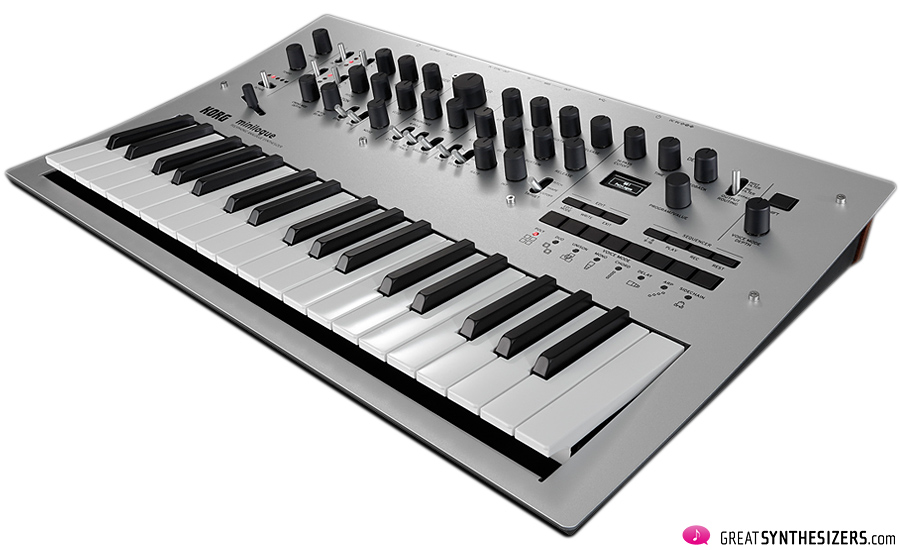

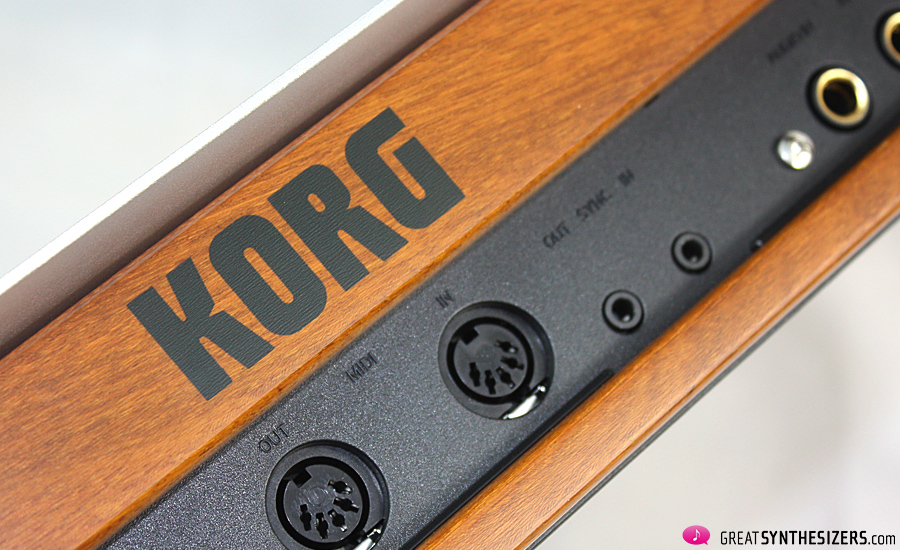
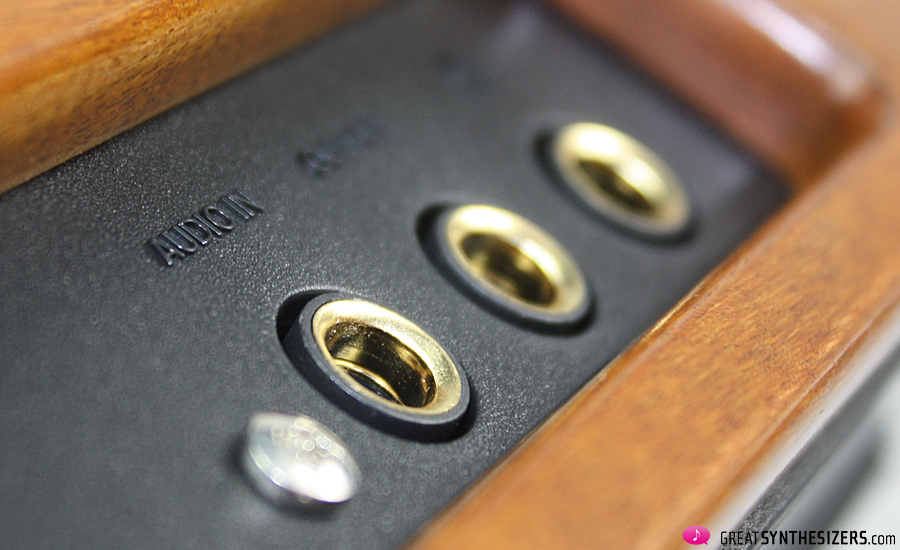

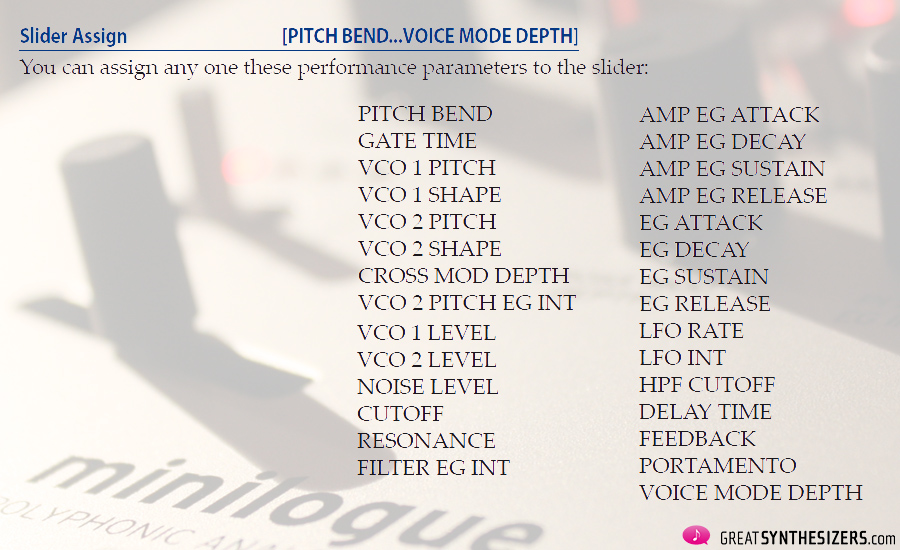
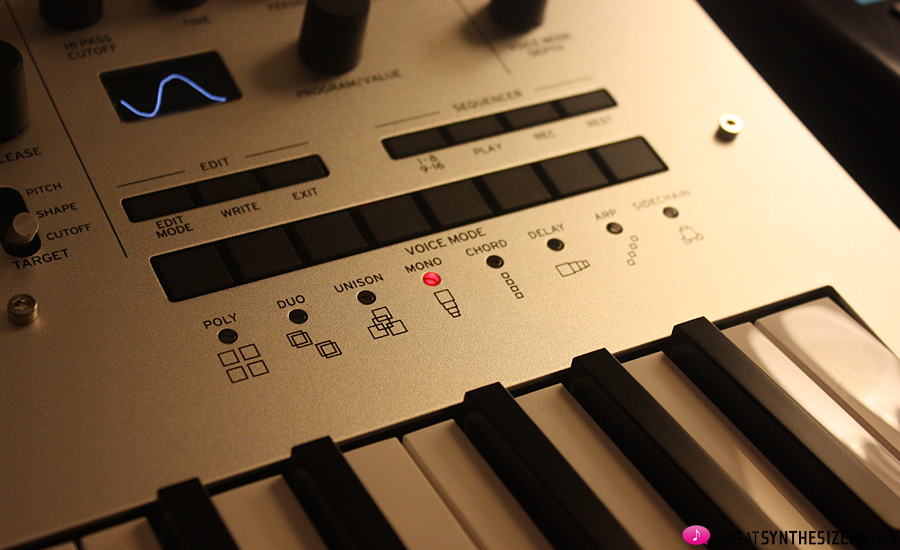
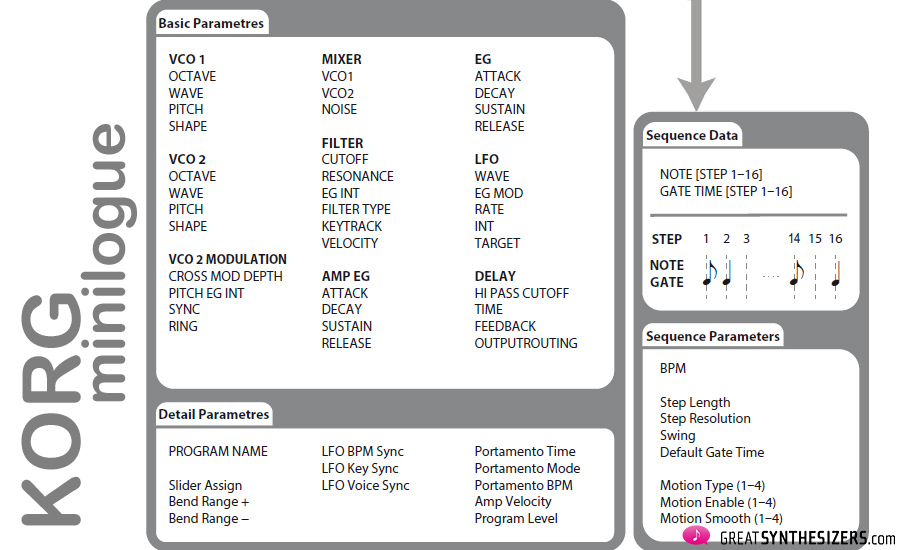
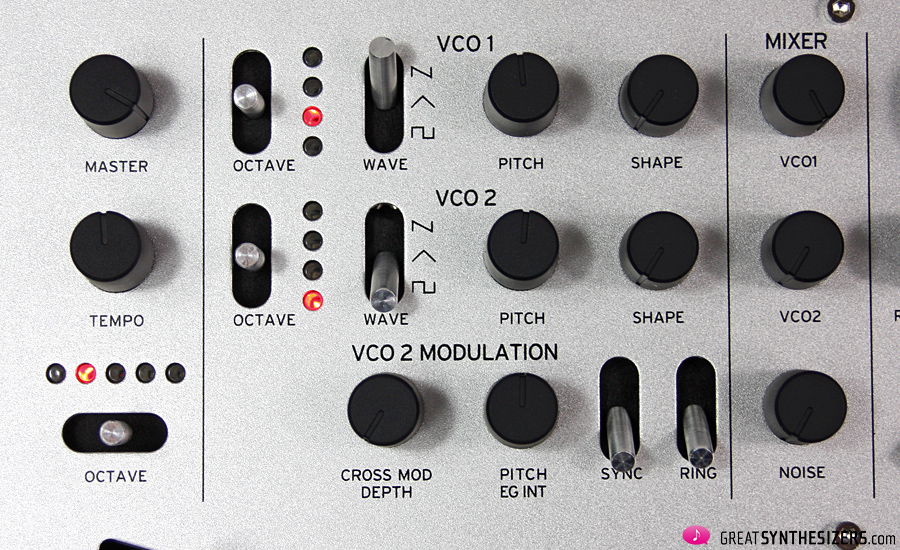
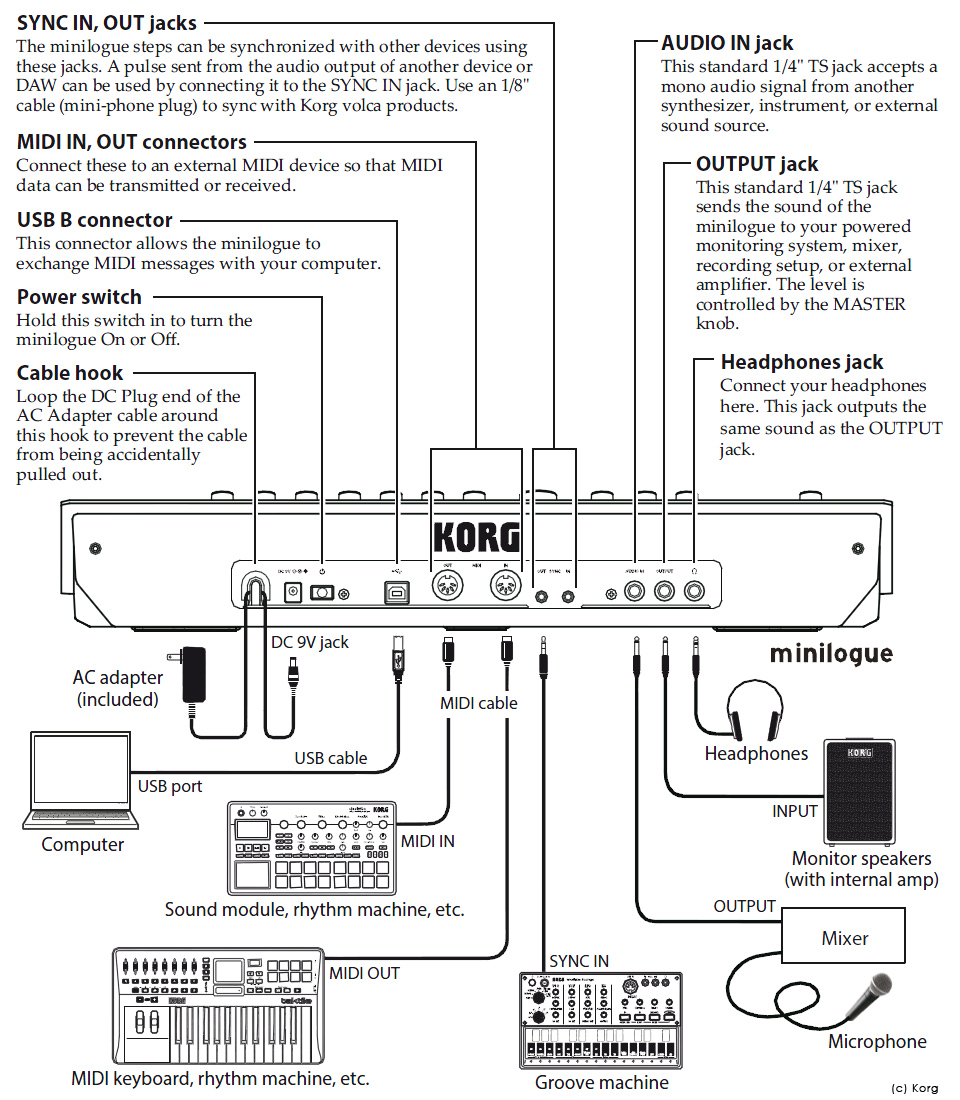
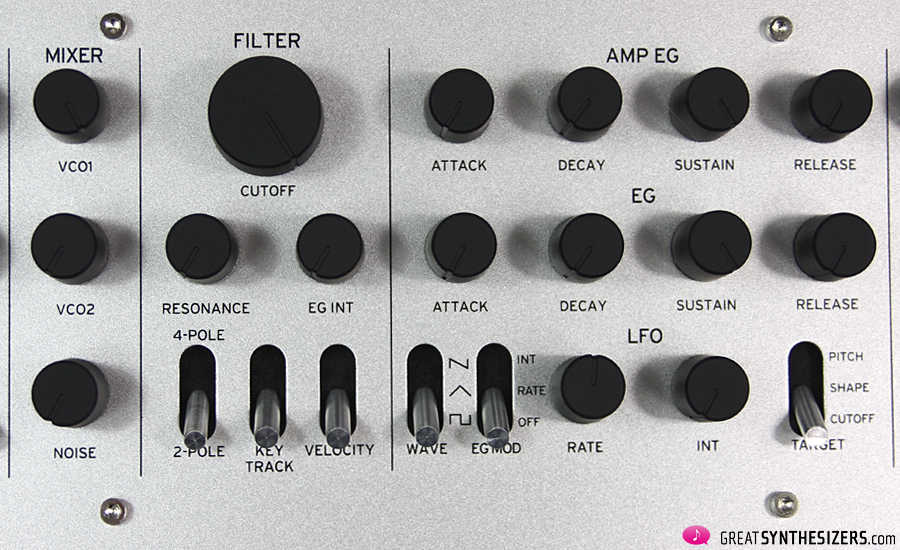
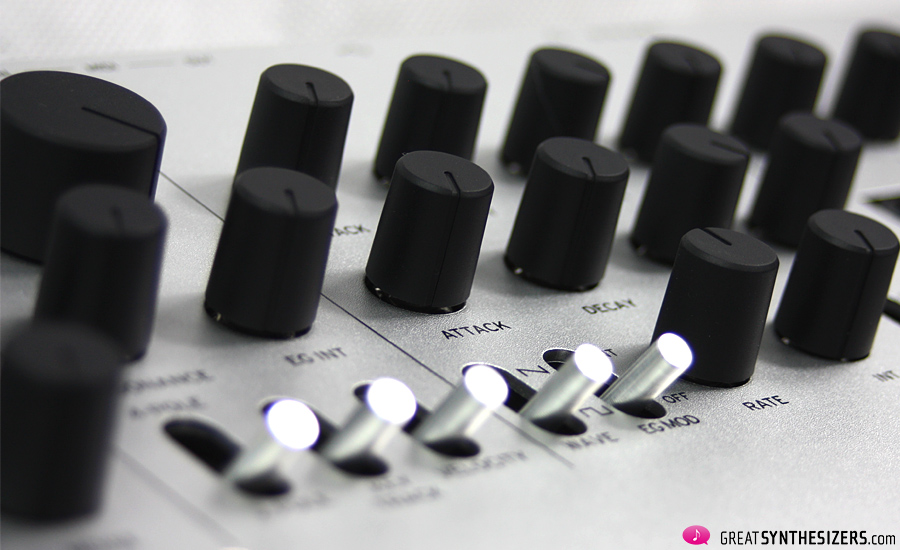
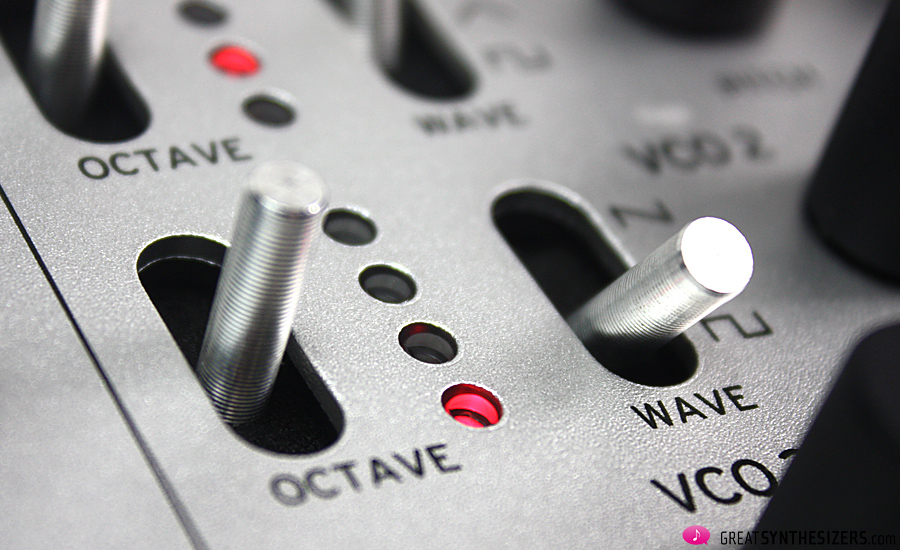
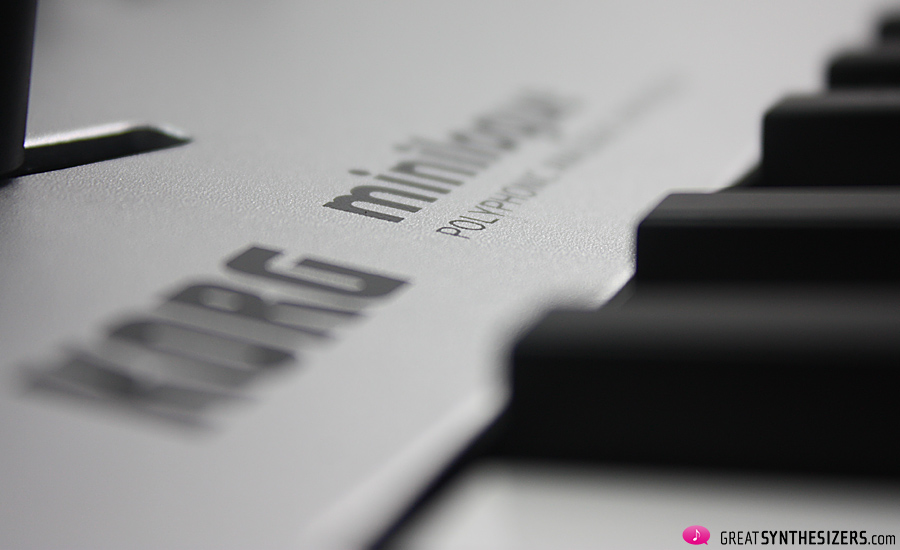

I hope it is as much fun as its distant great-grandfather, the MP-4 Mono/Poly. I too will wait to see if a ‘pro’ version appears, but for younger players with maybe less money, this looks fantastic.
Thanks for the well done reviews. It sounds like you like the Minilogue, but don’t love it. I’m looking for one synth to integrate into Logic, mostly to add low end analog punch to my House/UK Garage style bass lines. If you had to choose between the Minilogue, Bass Station 2 or Microbrute, which one would you recommend?
I get that poly vs mono is a tough comparison, but aside from that which do you prefer? I have my polysynth duties pretty well covered with UVI Falcon. Thanks.
Hello Markus …
I’d prefer the Bass Station II. Best monophonic synth of the last 10 years (in my opinion). The Novation gives you all the Zapps!, beats and other analog timbres, it has a multimode VCF, filter overdrive and much more. It definitely sounds more “analog” than the Minilogue, and with its 2 oscillators (plus sub-osc!), ringmodulator, etc. it raises above the (very beautiful) MicroBute. The Arturia might have the most unique sound character of all (thanks to the Steiner-Parker VCF), but the Novation is the workaholic :o) … tons and tons of useful features with a powerful down-to-earth analog sound.
Again, this is my very personal view … probably you should gather more feedback and then let your ears decide …
Cheers …
I’ve listened to tons of demos online including your excellent sound files and I agree that the BS II sounds wonderful. Versus the Minilogue, the BS II has beefier, fatter sounding oscillators. And it’s probably as close to my dream monosynth, the SH-101, as I’ll get at this price point. The 4-voice aspect of the Korg is tempting, but from what I’ve heard it sounds very good, but not great. For my music, a fat, punchy, track filling bassline is more important than pads or chords. And I like the fact that the BS II has a proper Sine wave for sub bass, and that it can create very interesting drum sounds. The Microbrute is tempting because of its semi-modular nature, great sound and low price, but I think the lack of patch memory will slow down my workflow. Thanks very much for taking the time to reply to my query. Cheers…
No problem!
PS: I’d also like to point to the MFB Dominion X. Very sophisticated, very powerful. 3 VCOs! Production stopped, though, so it’s only sold on the secondhand market …
Good article. I have just recently gotten the Minilogue and have been a bit on fence with it, and wondered if I should change for BSII or something else but think I may stay with the Mini. It’s got a lot of the things you mention going for it to make it a great learing, and sound design/exploring tool, the little osc display is great for ‘seeing’ how sound is shaped.
… if you change for the Bass Station II one day (somewhen in the far distant future), you shouldn’t be disappointed. I think the Novation BSII is the best analog synth / mini workstation on the market.
Anyway – have fun with the Minilogue (and its cute display :o).
Mono/Poly, Trident, Polysix are PRO sounding instruments, Minilogue is a toy with less “pure or vintage analog” type sound and more thin, cold and mudy than Nord A1 (virtual analog!)
It’s not a toy. It’s a budget analogue polysynth and ‘PRO’ is a meaningless statement. It’s not ‘thin, cold or muddy’ unless you want it to be. It won’t sound like synths built 30 years ago (and the Japanese synths you mention were actually considered budget synths at that time compared to the US designs)…but it can get close. It actually sounds closer to a Juno 6 than a Polysix. The MonoPoly is actually quite a clinical sounding synth in comparison. The Minilogue can hold it’s own sonically with vintage synths quite well. The control OS can be a bit glitchy and the S/N ratio could be better but for the $$ this is an excellent analogue 4 note Polysynth.
How much time did u really put learning its sounds and what they can do,its supposed to be an introduction to synths,and a damn good one it is,also ur gonna be surprised to see them turn up on a lot of stage rigs,then I quests u would say its a professional inst.(it became that the first time somebody got paid for a performance using one.
Listening to these demos after hearing the ones that were made for the Waldorf Rocket, I can’t believe they were made by the same person. These demos are flat and boring, in no way representative of the capabilities of this synth. To suggest that because it’s cheap it can’t be a tool for professionals is incredibly short-sighted. Minilogue has it’s limitations but anyone who knows what they are doing will be able to get some truly amazing sounds from this synth.
As for the slim keys, they are so good they have made me a total convert. I’ve hated mini-keys since I bought CZ101 in 1985 but the extra length in these keys makes it much easier to play black and white keys and I found it took me very little time to adjust to the narrower width. After a couple of months I feel as proficient on the Minilogue as I do on my full-size keyboards and I can even play mini keys with one hand and full size keys with the other without any problems.
The (sort of) good news on the sequencer front is the new Monologue, which takes it to the next level. To be honest, I haven’t touched the sequencer in the Minilogue because the 8 buttons make it very messy and it doesn’t really do anything I can’t do from my PC. But the Monologue has 16 buttons and it also has a Key-Trig button so you can trigger a sequence in any key. It is so flexible on the Monologue that you can actually use it as four extra LFOs if you want, by programming the motion tracks and just entering a single note.
Bottom line – don’t be put off by this so-so review, Minilogue is a terrific and very versatile synth that even a seasoned professional will find plenty of use for.
You’re wrong, the Minilogue is the best synthesizer on the market if you take the value for money. Bass Station II is a monophonic synthesizer, Minilogue is polyphonic, it’s a world of differences!
Is polyphony / monophony a criteria for evaluating synthesizers? Whether the one or the other is more important depends on how you create electronic music.
It’s hopefully the sound architecture itself that determins what sonic capabilities are at your fingertips. And in that respect, Bass Station II is – at least in my experience – years ahead.
Anyway, Minilogue is a brilliant, highly respectable and very expressive synthesizer …
The question whether the Minilogue is an “introductory” or “pro” synth is easily answered. It is both depending on what you want. If a pro synth simply means that professional musicians could use it, then you only need to look at for example people like Bill Laurance. He is a very accomplished jazz pianist who uses the Minilogue to accompany himself on the piano (https://www.youtube.com/watch?v=iFnaYfUOnG0). So yes, it is an instrument used by pros.
Is is a good introductory synth ? Yes I think it is, for many reasons, but I believe that the one thing that makes it especially suitable for those new to synthesizers is that you can do a lot with this synth without needing to go into complex menus. All the stuff you need to set up a great patch is right in front of you on the panel. What I do find though is that to get the absolute best out of it you will need to spend time and practice because even though I am a reasonably experienced synthesizer player, I found that only after some practice and learning for a while I was starting to get the really interesting sounds out of this instrument.
Finally, the discussion about whether the sound that the Minilogue produces is good or bad is a bit pointless, because like so many things in live this is very much a matter of taste. I happen to love the sound of the Minilogue, but likewise I can imagine that some people don’t. In the same way I am not that keen on the sound of most Moogs, Rolands or Yamahas, but love the sound of most Korgs, Prophets, APRs and Buchlas.